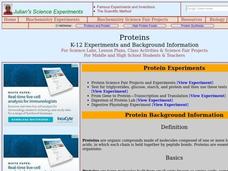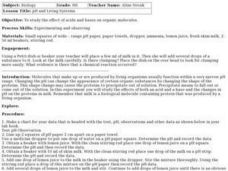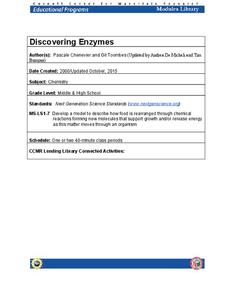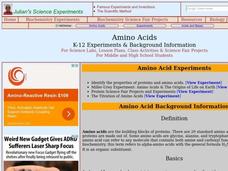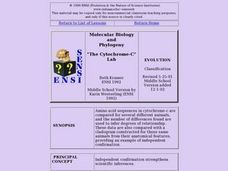Curated OER
Testing for Life
Students test for organic molecules to determine if a solution contains once living molecules. In this characteristics of life lesson, students test common liquids for the presence of organic molecules, including starch, protein, and...
Curated OER
Testing for Lipids, Proteins and Carbohydrates
Young scholars perform tests for the presence of certain macromolecules. In this health and biology lesson, students rotate in groups to three lab stations and perform tests for proteins, lipids, and carbohydrates found in...
Curated OER
Proteins
Students conduct a variety of experiments to explore protein. In this biology lesson plan, students solve a mystery by testing for the presence of glucose, protein starch and triglycerides. They explain how DNA transcription and...
Curated OER
Denaturing Proteins
Students investigate how to denature proteins. In this denaturing protein lesson plan, students explore the different ways to denature proteins in the lab. They use heat, acids and bases, organic compounds and heavy metals to denature...
Curated OER
Structural Changes in a Protein
Learners observe and manipulate the structure of a protein. They form an alpha helix, a beta sheet, and add disulfide bonds. They create a multimeric protein and compare their location with other students.
Curated OER
Effects of pH on Organic Molecules
Students investigate the effects of an acid and a base on the structure of milk protein. They observe the changes to droplets of milk when adding ammonia and lemon juice and relate the changes to old, curdled milk. An extension using...
Curated OER
Catering Middle-School Science: Monomers, Polymers, and Macromolecules
Students investigate foods. In this biology lesson plan, students will conduct testing on different types of foods as they learn about different molecules that make them up. Students will also learn about the shapes of the molecules.
Serendip
Cells as Molecular Factories
Cells are both made of molecules and make molecules all at the same time! An exploratory lesson provides a means for scholars to research the components of cells made of molecules and also investigate the molecule-producing power of...
Cornell University
Discovering Enzymes
Explore the function of enzymes through a series of lab investigations. Learners use household enzymes such as hydrogen peroxide to model the role of enzymes. The enzymes break down proteins with and without a catalyst.
Curated OER
Nucleic Acids and Protein Synthesis
Tenth graders complete a vocabulary assignment based on terms in the unit. They complete appropriate worksheets as each section of the unit is completed. They participate in classroom discussions. They construct a model of a DNA molecule.
Curated OER
Proteins Expressed At Different Stages
Students investigate protein electrophoresis in a lab setting. Full laboratory equipment is needed and safety should be taught. The level of prior knowledge needed to perform lab is high and is ideal for an honors class.
Cornell University
The Making of Macromolecules
Compare and contrast macromolecules made from the same elements. Young scholars learn how the structure of a molecule has as much influence on a compound as the elements in the molecule. They experiment with molecular model kits to...
Curated OER
Protein Synthesis and Words
Students explain the roles of mRNA, tRNA and ribosomes. They explain how mutations can occur in an individual. Students simulate parts of a cell to access about the process of protein synthesis.
Curated OER
Testing for Life
Students discuss food and the food groups and their organic nature. They test 3 different solutions and test for protein, starch and glucose. In addition, they create a master table on the board to collect all the teams results.
Curated OER
Amino Acids
Students explore what amino acids are, their history and how they are used in technology. In this protein lesson students identify the properties of proteins and amino acids.
Curated OER
What is Everything Made of?
Students observe a demonstration on how we see space between water molecules. In this experimental lesson students discover what elements make up the things around them and discuss what they learned.
Curated OER
Using Ion Exchange Chromatography to Separate Proteins
Young scholars explore protein purification by separating a positively charged molecule, lysozyme, from a negatively charged molecule, albumin, at neutral pH using ion exchange chromatography.
Curated OER
What's on Your Plate?
Young scholars demonstrate the path of food in the body. In this biology lesson, students conduct an experiment to determine how large the the digestive system is. They name the different organs involved in the digestive process.
Curated OER
Molecular Approaches to Evolution
Young scholars examine the molecular studies of organisms that have led to a new era in their understanding of speciation and evolutionary relationships. Students study the allelic frequency of genes controlling specific molecules and...
Curated OER
The Cytochrome-C Lab
Students examine a method biologists use to try to determine relationships. They examine how amino acid sequences have been determined for a number of proteins, and how scientists can make inferences about DNA based on the amino acid...
Curated OER
Polymers
Students explore online tutorial on polymers. In this chemistry lesson, they create two polymers in the lab and compare their properties. They write a sales letter about their new and improved polymer product.
Curated OER
There's Always Room For Jell-O
Students explore the breakdown of proteins. They cut wells in Jell-O and observe as the detergent digests the Jell-O. Students record their observations and take measurements.
Curated OER
Identifying Food Nutrients
High schoolers pretend they are a food-quality tester. They develop a kit to test food for sugars, starches, proteins and lipids. They answer questions to complete the lesson plan.
Curated OER
Construction of a Hemoglobin Gene
Students see how eight pairs of triplets are equivalent to part of a gene and control a part of heredity. They comprehend how blood corpuscles manufacture normal hemoglobin. Students already comprehend that genes control the synthesis...


